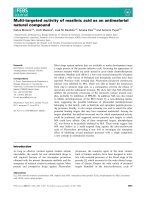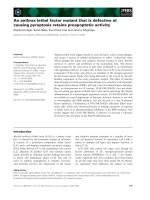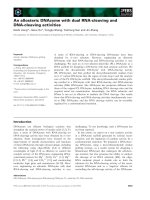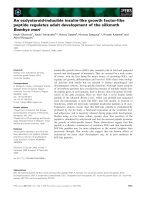Tài liệu Báo cáo khoa học: "An Empirical Investigation of Proposals in Collaborative Dialogues" docx
Bạn đang xem bản rút gọn của tài liệu. Xem và tải ngay bản đầy đủ của tài liệu tại đây (508.17 KB, 5 trang )
An Empirical Investigation of Proposals in Collaborative
Dialogues
Barbara Di Eugenio Pamela W. Jordan
Johanna D. Moore Richmond H. Thomason
Learning Research & Development Center, and Intelligent Systems Program
University of Pittsburgh
Pittsburgh, PA 15260, USA
{dieugeni, jordan, jmoore, thomason}@isp, pitt.
edu
Abstract
We describe a corpus-based investigation of propos-
als in dialogue. First, we describe our DR/compliant
coding scheme and report our inter-coder reliability
results. Next, we test several hypotheses about what
constitutes a well-formed proposal.
1 Introduction
Our project's long-range goal (see .
pitt.edu/'intgen/) is to create a unified architecture
for collaborative discourse, accommodating both in-
terpretation and generation. Our computational ap-
proach (Thomason and Hobbs, 1997) uses a form
of weighted abduction as the reasoning mechanism
(Hobbs et al., 1993) and modal operators to model
context. In this paper, we describe the corpus study
portion of our project, which is an integral part
of our investigation into recognizing how conversa-
tional participants coordinate agreement. From our
first annotation trials, we found that the recogni-
tion of "classical" speech acts (Austin, 1962; Searle,
1975) by coders is fairly reliable, while recognizing
contextual relationships (e.g., whether an utterance
accepts a proposal) is not as reliable. Thus, we ex-
plore other features that can help us recognize how
participants coordinate agreement.
Our corpus study also provides a preliminary as-
sessment of the Discourse Resource Initiative (DR/)
tagging scheme. The DRI is an international "grass-
roots" effort that seeks to share corpora that have
been tagged with the core features of interest to
the discourse community. In order to use the core
scheme, it is anticipated that each group will need to
refine it for their particular purposes. A usable draft
core scheme is now available for experimentation (see
Treebank/dri-home.html). Whereas several groups
are working with the unadapted core DR/ scheme
(Core and Allen, 1997; Poesio and Traum, 1997),
we have attempted to adapt it to our corpus and
particular research questions.
First we describe our corpus, and the issue of
tracking agreement. Next we describe our coding
scheme and our intercoder reliability outcomes. Last
we report our findings .on tracking agreement.
2 Tracking Agreement
Our corpus consists of 24 computer-mediated
dialogues 1 in which two participants collaborate on
a simple task of buying furniture for the living and
dining rooms of a house (a variant of the task in
(Walker, 1993)). The participants' main goal is to
negotiate purchases; the items of highest priority are
a sofa for the living room and a table and four chairs
for the dining room. The problem solving task is
complicated by several secondary goals: 1) Match
colors within a room, 2) Buy as much furniture as
you can, 3) Spend all your money. A point system
is used to motivate participants to try to achieve as
many goals as possible. Each subject has a bud-
get and inventory of furniture that lists the quanti-
ties, colors, and prices for each available item. By
sharing this initially private information, the partici-
pants can combine budgets and select furniture from
either's inventory. The problem is collaborative in
that all decisions have to be consensual; funds are
shared and purchasing decisions are joint.
In this context, we characterize an agreement as
accepting a partner's suggestion to include a specific
furniture item in the solution. In this paper we will
focus on the issue of recognizing that a suggestion
has been made (i.e. a proposal). The problem is not
easy, since, as speech act theory points out (Austin,
1962; Searle, 1975), surface form is not a clear indi-
cator of speaker intentions. Consider excerpt (1): 2
(1) A: [35]: i have a blue sofa for 300.
[36]: it's my cheapest one.
B: [37]: I have 1 sofa for 350
[38]: that is yellow
[39]: which is
my cheapest,
[40]: yours sounds good.
[35] is the first mention of a sofa in the conversa-
x Participants work in
separate rooms
and communicate via
the
computer interface. The interface prevents interruptions.
2We broke the dialogues into utterances, partly following
the
algorithm in (Passonneau, 1994).
325
tion and thus cannot count as a proposal to include
it in the solution. The sofa A offers for considera-
tion, is effectively proposed only after the exchange
of information in [37] [39].
However, if the dialogue had proceeded as below,
[35'] would count as a proposal:
(2) B: [32']: I have 1 sofa for 350
[33']:
that
is yellow
[34']: which is my
cheapest.
A: [35']: i have a blue sofa for 300.
Since context changes the interpretation of [35], our
goal is to adequately characterize the context. For
this, we look for guidance from corpus and domain
features. Our working hypothesis is that for both
participants context is partly determined by the do-
main reasoning situation. Specifically, if the suitable
courses of action are highly limited, this will make
an utterance more likely to be treated as a proposal;
this correlation is supported by our corpus analysis,
as we will discuss in Section 5.
3 Coding Scheme
We will present our coding scheme by first describing
the core DR/ scheme, followed by the adaptations
for our corpus and research issues. For details about
our scheme, see (Di Eugenio et al., 1997); for details
about features we added to DR/, but that are not
relevant for this paper, see (Di Eugenio et al., 1998).
3.1 The DRI Coding Scheme
The aspects of the core DR/scheme that apply to
our corpus are a subset of the dimensions under
Forward- and Backward-Looking Functions.
3.1.1 Forward-Looking Functions
This dimension characterizes the potential effect
that an utterance Ui has on the subsequent dialogue,
and roughly corresponds to the classical notion of
an illocutionary act (Austin, 1962; Searle, 1975). As
each Ui may simultaneously achieve multiple effects,
it can be coded for three different aspects: State-
ment, Influence-on-Hearer, Influence-on-Speaker.
Statement. The primary purpose of Statements is
to make claims about the world. Statements are sub-
categorized as an Assert when Speaker S is trying to
change Hearer H's beliefs, and as a Reassert if the
claim has already been made in the dialogue.
Influence-on-Hearer (I-on-H). A Ui tagged with
this dimension influences H's future action. DR/dis-
tinguishes between S merely laying out options for
H's future action (Open-Option), and S trying to get
H to perform a certain action (see Figure 1). Infe-
R°quest includes all actions that request informa-
tion, in both explicit and implicit forms. All other
actions 3 are Action-Directives.
3Although this may cause future problems (Tuomela,
i' Is S
discussing potential actions
of H?
', Is S ~'-th-g-to get H to d
thing?
:
Open-Op.on
;;-/ -%.o o.
Is 14
supposed to provide information'?
[
3
( ^otio Diroo.vo
Figure 1: Decision Tree for Influence-on-Hearer
Influence-on-Speaker (I-on-S). A Ui tagged with
this dimension potentially commits S (in varying de-
grees of strength) to some future course of action.
The only distinction is whether the commitment is
conditional on H's agreement (Offer) or not (Com-
mit). With an Offer, S indicates willingness to com-
mit to an action if H accepts it. Commits include
promises and other weaker forms.
3.1.2 Backward Functions
This dimension indicates whether Ui is unsolicited,
or responds to a previous Uj or segment. 4 The tags
of interest for our corpus are:
• Answer: Ui answers a question.
• Agreement:
1. Ui Accept/Rejects if it indicates S's attitude to-
wards a belief or proposal embodied in its an-
tecedent.
2. Ui Holds if it leaves the decision about the pro-
posal embodied in its antecedent open pending
further discussion.
3.2 Refinements to Core Features
The core DRI manual often does not operationalize
the tests associated with the different dimensions,
such as the two dashed nodes in Figure 1 (the shaded
node is an addition that we discuss below). This
resulted in strong disagreements regarding Forward
Functions (but not Backward Functions) during our
initial trials involving three coders.
Statement, In the current DR/manual, the test
for Statement is whether
Ui can
be followed by
"That's not true.". For our corpus, only syntactic
imperatives or interrogatives were consistently fil-
tered out by this purely semantic test. Thus, we
refined it by appealing to syntax, semantics, and do-
main knowledge: Ui is a Statement if it is declarative
1995), DRI
considers
joint
actions
as decomposable into in-
dependent Influence-on-Speaker / Hearer dimensions.
4Space
constraints prevent discussion
of segments.
326
and it is 1) past; or 2) non past, and contains a sta-
tive verb; or 3) non past, and contains a non-stative
verb in which the implied action:
• does not require agreement in the domain;
• or is supplying agreement.
For example, We could start in the living room is
not tagged as a statement if meant as a suggestion,
i.e. if it requires agreement.
I-on-H and I-on-S. These two dimensions de-
pend on the potential action underlying U~ (see the
root node in Figure 1 for I-on-H). The initial dis-
agreements with respect to these functions were due
to the coders not being able to consistently identify
such actions; thus, we provide a definition for ac-
tions in our domain, s and heuristics that correlate
types of actions with I-on-H/I-on-S.
We have two types of potential actions: put fur-
niture item X in room Y and remove furniture item
X from room Y. We subcategorize them as specific
and general. A specific action has all necessary pa-
rameters specified (type, price and color of item, and
room). General actions arise because all necessary
parameters are not set, as in I have a blue sofa ut-
tered in a null context.
Heuristic for I-on-H (the shaded node in Fig-
ure 1). If H's potential action described by Ui is
specific, Ui is tagged as Action-Directive, otherwise
as Open-Option.
Heuristic for I-on-S. Only a Ui that describes S's
specific actions is tagged with an 1-on-S tag.
Finally, it is hard to offer comprehensive guidance
for the test is S trying to get H to do something? in
Figure 1, but some special cases can be isolated. For
instance, when S refers to one action that the partic-
ipants could undertake, but in the same turn makes
it clear the action is not to be performed, then S is
not trying to get H to do something. This happens in
excerpt (1) in Section 2. A specific action (get B's
$350 yellow sofa) underlies [38], which qualifies as
an Action-Directive just like [35]. However, because
of [40], it is clear that B is not trying to get A to use
B's sofa. Thus, [38] is tagged as an Open-Option.
3.3 Coding for problem solving features
In order to investigate our working hypothesis about
the relationship between context and limits on the
courses of action, we coded each utterance for fea-
tures of the problem space. Since we view the prob-
lem space as a set of constraint equations, we decided
to code for the variables in these equations and the
number of possible solutions given all the possible
assignments of values to these variables.
The variables of interest for our corpus are the ob-
jects of type t in the goal to put an object in a room
(e.g. varsola, vartabte
or
varchairs).
For a solution to
5Our definition of actions does not apply to Into-Requests,
as the latter are easy to recognize.
327
[[ Stat. [I-on-H II-on-S H Answer [Agr. II
II "831 .72 I .72 II .79 I .54 II
Table 1: Kappas for Forward and Backward Func-
tions
exist to the set of constraint equations, each varl in
the set of equations must have a solution. For exam-
ple, if 5 instances of sofas are known for varsola, but
every assignment of a value to varsoIa violates the
budget constraint, then varsola and the constraint
equations are unsolvable.
We characterize the solution size for the problem
as determinate if there is one or more solutions and
indeterminate otherwise. It is important to note
that the set of possible values for each vari is not
known at the outset since this information must be
exchanged during the interaction. If S supplies ap-
propriate values for vari but does not know what H
has available for it then we say that no solution is
possible at this time. It is also important to point
out that during a dialogue, the solution size for a set
of constraint equations may revert from determinate
to indeterminate (e.g. when S asks what else H has
available for a vari).
4
Analysis of the Coding Results
Two coders each coded 482 utterances with the
adapted DRI features (44% of our corpus). Table 1
reports values for the Kappa (K) coefficient of agree-
ment (Carletta, 1996) for Forward and Backward
Functions .6
The columns in the tables read as follows: if utter-
ance Ui has tag X, do coders agree on the subtag?
For example, the possible set of values for I-on-H
are: NIL (Ui is not tagged with this dimension),
Action-Directive, Open-Option, and Info-Request.
The last two columns probe the subtypes of Back-
ward Functions: was Ui tagged as an answer to the
same antecedent? was Ui tagged as accepting, re.
jecting, or holding the same antecedent? T
K factors out chance agreement between coders;
K=0 means agreement is not different from chance,
and K=I means perfect agreement. To assess the
import of the values 0 <: K < 1 beyond K's sta-
tistical significance (all of our K values are signifi-
cant at p=0.000005), the discourse processing com-
munity uses Krippendorf's scale (1980) 8, which dis-
eFor problem solving features, K for two doubly coded
dialogues was > .8. Since reliability was good and time was
short, we used one coder for the remaining dialogues.
7In general, we consider 2 non-identical antecedents as
equivalent if one is a subset of the other, e.g. if one is an
utterance Uj and the other a segment containing Uj.
SMore forgiving scales exist but have not yet been dis-
cussed by the discourse processing community, e.g. the one
in (Rietveld and van Hour, 1993).
II Stat. I I-on-H I I-on-S II Answer I Agr. II
I] "681 . 71 I N/Sa II .81 I .43 II
aN/S
means not significant
Table 2: Kappas from (Core and Allen 97)
counts any variable with K < .67, and allows tenta-
tive conclusions when .67 < K < .8 K, and definite
conclusions when K>.8. Using this scale, Table 1
suggests that Forward Functions and Answer can be
recognized far more reliably than Agreement.
To assess the DRI effort, clearly more experiments
are needed. However, we believe our results show
that the goal of an adaptable core coding scheme is
reasonable. We think we achieved good results on
Forward Functions because, as the DRI enterprise
intended, we adapted the high level definitions to
our domain. However, we have not yet done so for
Agreement since our initial trial codings did not re-
veal strong disagreements; now given our K results,
refinement is clearly needed. Another possible con-
tributing factor for the low K on Agreement is that
these tags are much rarer than the Forward Func-
tion tags. The highest possible value for K may be
smaller for low frequency tags (Grove et al., 1981).
Our assessment is supported by comparing our re-
sults to those of Core and Allen (1997) who used the
unadapted DRI manual see Table 2. Overall, our
Forward Function results are better than theirs (the
non significant K for I-on-S in Table 2 reveals prob-
lems with coding for that tag), while the Backward
Function results are compatible. Finally, our assess-
ment may only hold for task-oriented collaborative
dialogues. One research group tried to use the DRI
core scheme on free-flow conversations, and had to
radically modify it in order to achieve reliable coding
(Stolcke et al., 1998).
5 Tracking Propose and Commit
It appears we have reached an impasse; if human
coders cannot reliably recognize when two partici-
pants achieve agreement, the prospect of automat-
ing this process is grim. Note that this calls into
question analyses of agreements based on a single
coder's tagging effort, e.g. (Walker, 1996). We think
we can overcome this impasse by exploiting the relia-
bility of Forward Functions. Intuitively, a U~ tagged
as Action-Directive + Offer should correlate with
a proposal given that all actions in our domain
are joint, an Action-Directive tag always co-occurs
with either Offer (AD+O) or Commit (AD÷C). Fur-
ther, analyzing the antecedents of Commits should
shed light on what was treated as a proposal in the
dialogue. Clearly, we cannot just analyze the an-
tecedents of Commit to characterize proposals, as a
Det Indet Unknown
AD+O 25 7 0
Open-Option 2 2 0
AD+C 10 2 0
Other 4 2 4
Table 3: Antecedents of Commit
proposal may be discarded for an alternative.
To complete our intuitive characterization of a
proposal, we will assume that for a Ui to count as
a well-formed proposal (WFP), the context must be
such that enough information has already been ex-
changed for a decision to be made. The feature so-
lution size represents such a context. Thus our first
testable characterization of a WFP is:
1.1 Ui counts as a WFP if it is tagged as Action-
Directive + Offer and if the associated solution
size is determinate.
To gain some evidence in support of 1.1, we
checked whether the hypothesized WFPs appear as
antecedents of Commits? Of the 32 AD÷Os in Ta-
ble 3, 25 have determinate solution size; thus, WFPs
are the largest class among the antecedents of Com-
mit, even if they only account for 43% of such an-
tecedents. Another indirect source of evidence for
hypothesis 1.1 arises by exploring the following ques-
tions: are there any WFPs that are not committed
to? if yes, how are they dealt with in the dialogue?
If hypothesis 1.1 is correct, then we expect that each
such Ui should be responded to in some fashion. In
a collaborative setting such as ours, a partner can-
not just ignore a WFP as if it had not occurred.
We found that there are 15 AD+Os with determi-
nate solution size in our data that are not commit-
ted to. On closer inspection, it turns out that 9
out of these 15 are actually indirectly committed to.
Of the remaining 6, four are responded to with a
counterproposal (another AD+O with determinate
solution size). Thus only two are not responded to
in any fashion. Given that these 2 occur in a di-
alogue where the participants have a distinctively
non-collaborative style, it appears hypothesis 1.1 is
supported.
Going back to the antecedents of Commit (Ta-
ble 3), let's now consider the 7 indeterminate
AD÷Os. They can be considered as tentative pro-
posals that need to be negotiated. 1° To further re-
fine our characterization of proposals, we explore the
hypothesis:
9Antecedents of
Commits
are not tagged. We recon-
structed them from either
variable
tags or when Ui has both
Commit and Accept tags,
the antecedent
of the Accept.
1°Becanse of our heuristics of tagging specific actions as
ActionDirectives,
these utterances
are not
Open-Options.
328
1.2 When the antecedent of a
Commit
is an
AD+O
and indeterminate, the intervening dialogue
renders the solution size determinate.
In 6 out of the 7 indeterminate antecedent
AD+Os,
our hypothesis is verified (see excerpt (1),
where [35] is an
AD+ 0
with indeterminate solution
size, and the antecedent to the
Commit
in [40]).
As for the other antecedents of
Commit
in Table 3,
it is not surprising that only 4
Open-Options
occur
given the circumstances in which this tag is used (see
Figure 1). These
Open-Options
appear to function
as tentative
proposals like indeterminate
AD+ Os, as
the dialogue between the
Open-Option
and the
Com-
mit
develops according to hypothesis 1.2. We were
instead surprised that
AD+Cs
are a very common
category among the antecedents of
Commit
(20%);
the second commit appears to simply reconfirm the
commitment expressed by the first (Walker, 1993;
Walker, 1996), and does not appear to count as a
proposal. Finally, the
Other
column is a collection
of miscellaneous antecedents, such as
Info-Requests
and cases where the antecedent is unclear, that need
further analysis. For further details, see (Di Eugenio
et al., 1998).
6 Future Work
Future work includes, first, further exploring the fac-
tors and hypotheses discussed in Section 5. We char-
acterized WFPs as
AD+Os
with determinate solu-
tion size: a study of the features of the dialogue pre-
ceding the WFP will highlight how different options
are introduced and negotiated. Second, whereas our
coders were able to reliably identify Forward Func-
tions, we do not expect computers to be able to do so
as reliably, mainly because humans are able to take
into account the full previous context. Thus, we are
interested in finding correlations between Forward
Functions and "simpler" tags.
Acknowledgements
This material is based on work supported by the Na-
tional Science Foundation under Grant No. IRI-9314961.
We wish to thank Liina Pyllk~inen for her contributions
to the coding effort, and past and present project mem-
bers Megan Moser and Jerry Hobbs.
References
John L. Austin. 1962.
How to Do Things With
Words.
Oxford University Press, Oxford.
Jean Carletta. 1996. Assessing agreement on classi-
fication tasks: the kappa statistic.
Computational
Linguistics,
22(2).
Mark G. Core and James Allen. 1997. Coding
dialogues with the DAMSL annotation scheme.
AAAI Fall Symposium on
Communicative Actions
in Human and Machines,
Cambridge MA.
Barbara Di Eugenio, Pamela W. Jordan, and Li-
ina PylkkLrmn. 1997. The COCONUT project:
Dialogue annotation manual, .
pitt.edu/'intgen/research-papers.
Barbara Di Eugenio, Pamela W. Jordan, Rich-
mond H. Thomason, and Johanna D. Moore.
1998. The Acceptance cycle: An empirical inves-
tigation of human-human collaborative dialogues.
Submitted for publication.
William M. Grove, Nancy C. Andreasen, Pa-
tricia McDonald-Scott, Martin B. Keller, and
Robert W. Shapiro. 1981. Reliability studies
of psychiatric diagnosis, theory and practice.
Archives General Psychiatry,
38:408-413.
Jerry Hobbs, Mark Stickel, Douglas Appelt, and
Paul Martin. 1993. Interpretation as abduction.
Artificial Intelligence,
63(1-2):69-142.
Klaus Krippendorff. 1980.
Content Analysis: an In-
troduction to its Methodology.
Beverly Hills: Sage
Publications.
Rebecca J. Passonneau. 1994. Protocol for coding
discourse referential noun phrases and their an-
tecedents. Technical report, Columbia University.
Massimo Poesio and David Traum. 1997. Rep-
resenting conversation acts in a unified seman-
tic/pragmatic framework. AAAI Fall Symposium
on
Communicative Actions in Human and Ma-
chines,
Cambridge MA.
T. Rietveld and R. van Hout. 1993.
Statistical Tech-
niques .for the Study of Language and Language
Behaviour.
Mouton de Gruyter.
John R. Searle. 1975. Indirect Speech Acts. In
P. Cole and J.L. Morgan, editors,
Syntax and Se-
mantics 3. Speech Acts.
Academic Press.
A. Stolcke, E. Shriberg, R. Bates, N. Coccaro, D. Ju-
rafsky, R. Martin, M. Meteer, K. Ries, P. Taylor,
and C. Van Ess-Dykema. 1998. Dialog act model-
ing for conversational speech. AAAI Spring Sym-
posium on
Applying Machine Learning to Dis-
course Processing.
Richmond H. Thomason and Jerry R. Hobbs. 1997.
Interrelating interpretation and generation in an
abductive framework. AAAI Fall Symposium on
Communicative Actions in Human and Machines,
Cambridge MA.
Raimo Tuomela. 1995.
The Importance of Us.
Stan-
ford University Press.
Marilyn A. Walker. 1993.
Informational Redun-
dancy and Resource Bounds in Dialogue.
Ph.D.
thesis, University of Pennsylvania, December.
Marilyn A. Walker. 1996. Inferring acceptance and
rejection in dialogue by default rules of inference.
Language and Speech,
39(2).
329









